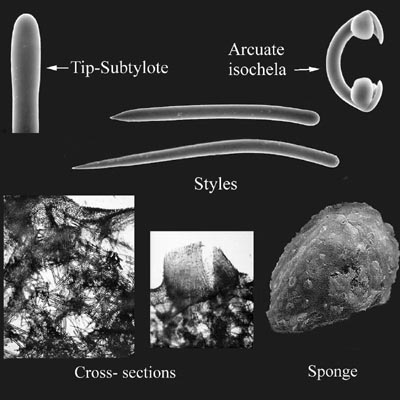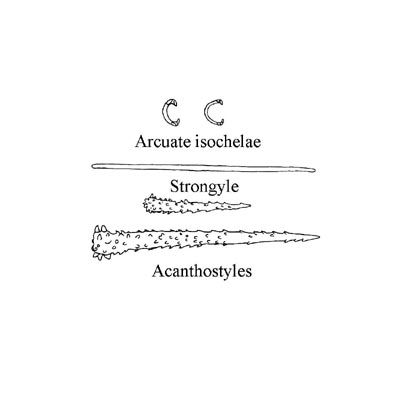[A]
Subtylotes - Tylotes present.
NO Strongyles present.
Diacts to 337 μm. |
 de Laubenfels, 1930 [of Green & Bakus, 1994]
de Laubenfels, 1930 [of Green & Bakus, 1994] |
Sponge:
Encrusting.
Surface: undulating.
Color: Alive: Pale drab, brown-orange.
Spicules: Megascleres:
(1) Styles:
176 -200-248- 327 um.
x 10 -13-14- 16 um.
Warning: Undefined array key 4 in /home/thackerdb2/public_html/casponges/programfiles/WCS_Key4.php on line 129
(2) Styles:
362 -409-481- 547 um.
x 17 -21-24- 27 um.
Warning: Undefined array key 4 in /home/thackerdb2/public_html/casponges/programfiles/WCS_Key4.php on line 129
(3) Subtylotes-Tylotes:
251 -307-327- 370 um.
x 5 -7- 9 um.
Warning: Undefined array key 4 in /home/thackerdb2/public_html/casponges/programfiles/WCS_Key4.php on line 129
Warning: Undefined array key 3 in /home/thackerdb2/public_html/casponges/programfiles/WCS_Key4.php on line 131
Microscleres:
Warning: Undefined array key 1 in /home/thackerdb2/public_html/casponges/programfiles/WCS_Key4.php on line 195
(1) Arcuate Isochelae:
30 -37-39- 47 um.
Warning: Undefined array key 3 in /home/thackerdb2/public_html/casponges/programfiles/WCS_Key4.php on line 212
Warning: Undefined array key 1 in /home/thackerdb2/public_html/casponges/programfiles/WCS_Key4.php on line 214
Skeleton:
Ectosome: Dermal membrane with Isochelae, below which are Tornotes more or less tangential to the surface.
Choanosome: Dense mesenchyme with ill-defined tracts to surface. These crudely echinated by Styles. The tracts form a loose reticulation.
Distribution: Southern to Northern California.
Depth: Intertidal to deep water.
Note: This form differs from the original description of Lissodendoryx kyma by having mostly Styles. If spined they are usually not as pronounced as those described by de Laubenfels. This is the most common form in California. See Page 142A, 142B and 166A for important information.
|
|
[B]
Strongyles present.
NO Subtylotes-Tylotes present.
Diacts to 200 μm.
|

| | Hymedesmia (Hymedesmia)
sp. B Green & Bakus, 1994 |
Sponge:
Encrusting fragments to < 0.2 mm thick.
Fatal error: Uncaught Error: Undefined constant "BConsistency" in /home/thackerdb2/public_html/casponges/programfiles/WCS_Key4.php:294
Stack trace:
#0 {main}
thrown in /home/thackerdb2/public_html/casponges/programfiles/WCS_Key4.php on line 294
| |